Supervised by: Liam Charles Obuobie MEng Hons, EngTech MIMechE. Liam is currently a final year Masters student of Mechanical Engineering at Newcastle University. He has secured a position as a Graduate Mechanical Building Services Engineer at Arup for post-graduate employment. His dissertation has garnered internation interest in further work.
Abstract
In this paper our main focus was bettering the current design of E-bikes with an intent to better the user-centred approach. This was done by directing our research on the Neuron E-bike company for reference, as well as other E-bike companies and environments worldwide. After compiling a HTA of the process, we identified that the problems were, user interface with the infrastructure, the battery range, the tires for a comfortable ride, software issues, and the anthropometrics of the bike. For each of these problems we individually researched them and came up with suggestions which we then conjoined to improve the concept of public E-bikes as a whole.
Introduction
Electric bikes, also known as E-bikes, an ever evolving and more convenient alternative to regular bicycles rapidly growing in popularity all over the world, with the number of users increasing significantly since the start of the COVID-19 pandemic in 2020 (Cooper et al., 2020). Due to their battery-powered motors and automatic pedalling assistance, E-bikes are largely used as they are convenient, punctual, labour-saving, fast and cheap (An et al., 2013). Although some may view E-bikes as unfamiliar and unapproachable, E-bikes can offer a convenient and enjoyable means of transport. Integrated features such as sensors ensure that the E-bikes can travel at a fast but suitable speed to ensure safety. It is important to note that the usage of an E-bike is distinctly different from normal bicycles, with data showing that E-bikers are more likely to use buses rather than bikes if they could no longer use E-bikes (Mobilities, 2021) .
Even though there has been global progress in combating global warming, as seen in the recent COP27 agreement on establishing the first fund aimed at providing financial assistance for the impacts of climate change, fossil fuel usage remains a major issue. With the deadlines to reduce fossil fuels quickly approaching, such as the 75% reduction in emissions from fossil fuel operations IEA Net Zero Emissions by 2050 Scenario, more ways of decreasing fossil fuel usage are desperately needed. With electrification being a key strategy in reducing oil dependency as well as the environmental impact of road transportation (Zhang, 2020), E-bikes may be a key part of the solution to make transport in urban areas more sustainable (Weiss et al., 2015). If E-bikes are successfully implemented, they may be able to replace other, more fossil fuel consuming modes of transport and become a viable and appealing eco-friendly lifestyle choice to individuals and perhaps businesses as well. In an E-Bike trial in West London boroughs, 83% of participants in Harrow responded positively to the E-bike after the trial and 55% of Hounslow participants said they were very likely to use an E-bike for work journeys in future. From this data, it can be observed that people can be very inclined to using E-bikes after trying them out.
As E-bikes are becoming increasingly common in many countries, they have the potential to be highly beneficial in preserving the environment and overall economic efficiency. We aim to find ways to optimise the design and infrastructure of public E-bikes through a user-centred approach. To go about this, our research paper will highlight some of the most prevalent issues facing public E-bike systems already in place today, including the components of an E-bike as well as the general issues with micro mobility such as safety and lifespan. This will be researched and presented through a user-centred design approach using human factor engineering which, in this case, assesses E-bikes through the needs and wants of users.
Aims & Objectives
Aims
– To optimise public E-bikes from a user-centred design approach
Objectives
– To design a HTA on the process of using a public E-bike based on the Neuron Mobility EB-1 E-bike.
– To analyse the HTA and select key areas to be potentially optimised which could have a significant impact on the user experience.
– To do research on available technology and current E-bike designs.
– To provide structured suggestions as to how public E-bikes can be optimised.
Methodology
1. Create a HTA of the process of using a public E-bike.
In order to optimise public E-bikes from a user-centred design perspective, a HTA needs to be produced to critically evaluate the general current user-experience of an E-bike. Hierarchical task analysis (HTA) is a core ergonomics approach with a pedigree of over 30 years continuous use (Stanton, 2006). This provides a clear perspective on the key tasks involved in public E-bike usage, presenting the most likely areas of optimisation as well as enabling detailed analysis of specific tasks which allows for more careful and holistic consideration of the usage experience. This also allows for the prioritisation of which aspects to optimise as the different tasks involved in using public E-bikes branch out and become increasingly detailed in the HTA.
The baseline E-bike which the HTA was based off is the Neuron Mobility EB-1 E-bike because it is a successful brand which rents out E-bikes that operates in several countries with highly developed urban areas such as Australia, New Zealand, the United Kingdom, and Canada. This allows for the analysis of an established rental E-bike product that is shown to have solid infrastructure to support it as well as good functionality. Additionally, it is the leading rental micro mobility technology developer in Australia and New Zealand, providing an already highly optimised product to analyse allowing for more effective optimisation.
2. Analyse HTA and select aspects of public E-bikes to analyse.
To determine which areas of public E-bikes should be optimised, the HTA was analysed, prioritising larger tasks and then moving on to the details of those tasks. This is because the larger tasks involved in using the public E-bike are likely to be the most significant aspects that can be optimised as they affect many of the subtasks involved in that task.
The areas selected for optimization in this paper were selected using our intuition and critical thinking about which areas we felt would be the most impactful in our own perspectives as potential users.
3. Literature research
To provide structured suggestions on how to optimise E-bikes, research was done on available literature to find the most optimal technology available that can be implemented into public E-bikes.
Neuron HTA Chart
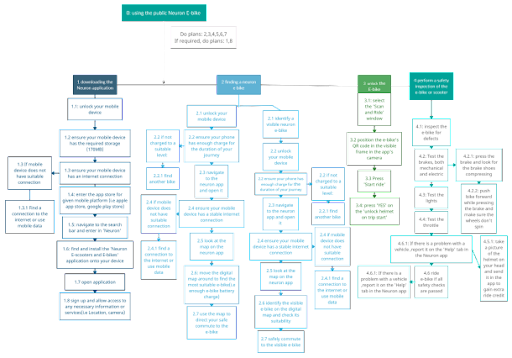
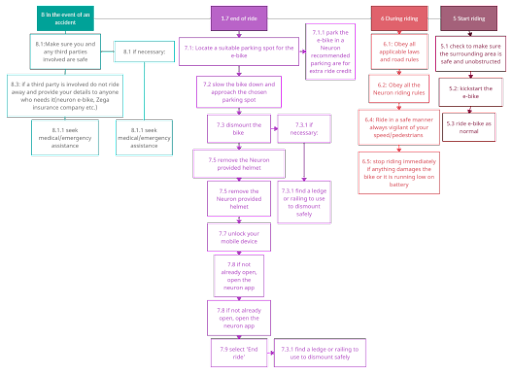
Hierarchical Task Analysis (HTA) has had over 30 continuous years of use and has become an essential ergonomics approach. It is deemed to be a very useful and versatile method for understanding tasks by decomposing the task into individual steps and providing graphical representation. This HTA graph represents the processes that a user would have to follow in order to successfully use a Neuron branded E-bike. From this HTA we plan to identify areas that may need improvement to improve accessibility.
Installed screens with user interfaces
We identified through analysis of the HTA that the use of a smartphone to be able to use the bike is necessary which may exclude parts of the population. In order to unlock the bike, the user needs to navigate through the app selecting multiple options before they can properly use the bike. This may cause problems for people who do not own a smartphone, the elderly and people with physically impairing conditions such as the partial loss of eyesight. In the UK over 2 million people are classified as visually impaired and are worse than 6/12 on the Snellen and over 80 percent are over the age of 65 (RNIB, 2022), therefore it is clear that optimising the bike and incorporating features that would support E-bike use for partially impaired people is crucial to accommodate as many people as possible. Another quite significant issue with using an app with quite small buttons is that groups with dexterity issues such as multiple sclerosis can likely have problems with using it as they cannot accurately press them or may accidentally press buttons they did not intend to. Changes to improve accessibility for these users can be as small as changing the size of the icons on the mobile app and these suggestions come with a disclaimer as many mobile phones already have integrated accessibility functions such as increasing the size of buttons or using a narrator. Furthermore, especially among the elderly, there is quite a large population of people who do not use or own smartphones which means that they have no way of accessing the public E-bike system. As can be seen in figure 2, almost 30 percent of people older than 55 do not own smartphones which cuts out an approximate 5 million people (30% of population from 55-85 from figure 3). Moreover, around one in five of the UK population (22%) live in poverty (JRF, 2022) which affects their ability to use the current Neuron E-bike. This is due to the fact that many may not be able to afford a mobile phone or if they can then the cost of internet or mobile data may be too high so it would be extremely difficult to use the bikes outside as they do not have any internet connection to use the app. Therefore, the use of an app can create many issues for people, and we have come up with some suggested designs to get around this problem.
In reference to plans 2 and 3 of the E-bike HTA (figure 1), the user needs to access their mobile device/smartphone to access the Neuron application. To overcome this problem, we have come up with two proposed changes. These are:
1. Large screens at charging stations
This idea consists of a single large touch screen device at each charging station that could be accessed by any people who wish to use the E-bike. This station would have features such as being able to scan QR codes from pre-bought bike unlocks that have either been printed out by the user or have a digital copy and alongside this would have a card reader for on-site purchases which means nothing more than a bank card is needed. This not only allows people with no phone to access it, as they don’t need to access the app but print a ticket off from the web app, but also people with aforementioned conditions who can get everything ready before the ride which means they can use their computers at home that may already have been changed to assist them in their purchase. This is already a very prominent and successful way of buying tickets as around one third of those who purchase rail tickets said they purchase them online and it can be assumed it has grown as these were values from 2018 (34%) (Public attitudes towards train services: results from the February 2018 Opinions and Lifestyle Survey, 2019). Our booth would resemble that of the one presented in figure 4. Moreover, not only would this help with issues such as lack of device or connection, but this would also benefit those with antecedent mentioned impairments. A large screen results in space for much larger icons which not only improves their visibility but also makes it easier to select. This would not cost too much for the producer as they would only have to install one screen with the infrastructure to work with the bikes for each station. However, this does not solve all issues. This would mean that the rider would have to start and end their ride at a charging station and not at their desired destination. Although this is an issue it still means the user can arrive at the vicinity of the location they desire and do not have to spend much more money on public transport which they may not be able to afford. A visual concept of this is displayed in figure 5.
2. Smaller screen implemented on each bike
Like the first suggestion, this idea puts an already integrated display onto the bikes to eliminate the need for a mobile device. This can already be observed as viable as most E-bikes already have displays to indicate speed, charge, maps etc. this would work much like the previous suggestion, and you would be able to pay through bank card. This idea is partially the opposite of the previous one as it solves many problems of the large screen but also lacks its advantages. It would allow users to get directly to their location as they can stop the ride through the bike but there is limited space so icons would not be as large, and it also may not have enough space for a scanner if made too small. This may also cause a problem with cost as equipping large numbers of bikes with screens will build up in cost. A visual concept of this is displayed in figure 6.
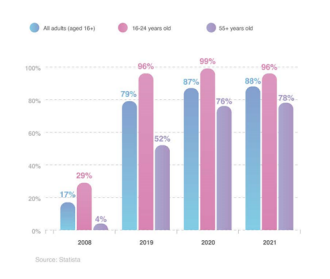
Figure 2: ‘UK mobile phone statistics 2022’ (Hiley, 2022)

Figure 3: ‘population of England 2022, by age group’ available at: (Statista, 2020) 9
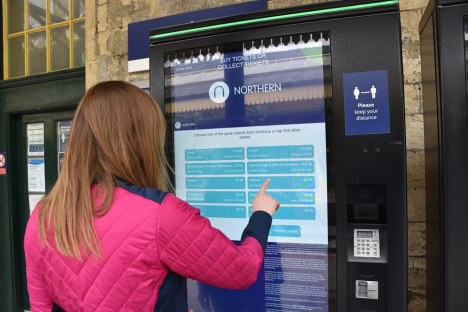
Figure 4: Northern railways ticket booth (Northern News, 2021)


Figure 5: CAD model of large screen display (MS)


Figure 6: CAD model of small screen display (MS)
3. HTA graph for new screen usage
The HTA graph below shows the process of using the first suggestion to ride the bike. The smaller screens would involve largely the same process.
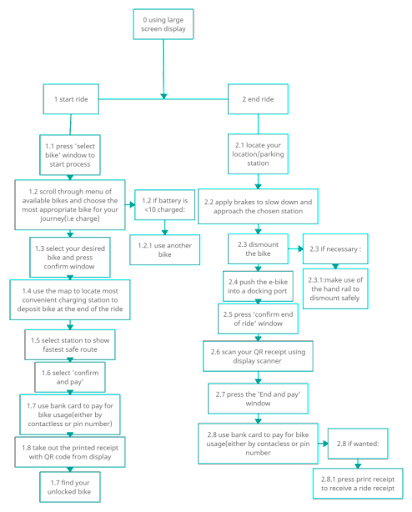
Tyre Suggestions
In this part of the paper the choice of the tyre will be explained. The goal is to pick the best fit-for-purpose tyre for a city bike which is mainly used on streets.
The tyre is very important for the performance of an E-bike. It consists of different components like profile, diameter, width, and the type of tyre like tubeless, tube or solid tyre. All these components can have different direct impacts on the E-bike’s performance.
Profile
There are different types of profiles which can be used. As we are optimising a city bike, only road, cyclocross and commuter tyres are relevant for us.
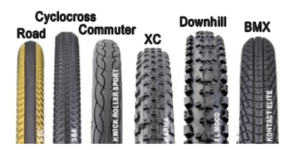
Figure 7: different types of profile (KBO Bike, 2021)
Road tyres are especially designed for being ridden on streets. They are between 23 and 25 mm wide and have a tread pattern, which decreases the contact area with the surface. They are quite light. But on wet surfaces, the risk of slipping is considerably high (KBO Bike, 2021).
Cyclocross tyres are the intermediate piece between road-, and mountain tyre. They are especially for gravel roads, and have good grip on snow (MomentumPlanet.ca, 2021), (KBO Bike, 2021).
Commuter tyres are developed for hard surfaces, like asphalt and are very good for being ridden under wet conditions. They have all-weather tread patterns which are smooth and flat. The wider the tyre, the more comfort it provides. They are normally used between 28 and 42 mm (KBO Bike, 2021).
Diameter
Another important component is the diameter. There are four main dimensions like 16-, 20-, 26- and 29-inches. However, 16-inch tyres have not been explored further because they do not perform well on streets.
20-inch tyres can be manoeuvred very easily, though they are easily affected by rocks and obstacles (KBO Bike, 2021).
26-inch tyres are the most common size. They are usually fatter and have more width. This increases the air volume which leads to higher suspension effect (KBO Bike, 2021).
On the one hand, the 29-inch tyre has more surface contact, but less friction. However, the grip is better because of the increased contact. With the 29-inch tyre it is easier to overcome obstacles, and the indolence is stored better, too. Which means that less energy is needed. Though, these tyres require a bigger frame, which decreases the manoeuvrability, and increases the weight (KBO Bike, 2021).
Width
The width of the tyre can be separated into two main categories like fat and thin tyres. The width of thin tyres is usually between 38 and 65mm. The decision between these two types has an impact on speed, suspension, range, manoeuvrability & stability, acquisition costs, lifetime of a tyre and weight.
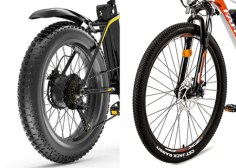
Figure 8: illustration fat and thin tires (Tom, 2022)
The speed of thin or fat tyres depend on the surface the E-bike is ridden on. Fat tyres are faster on uneven surfaces, which is caused by the suspension effect of the bigger air volume. Thin tyres are faster on even surfaces because they have less rolling resistance and are more aerodynamic. As fat tyres are heavier, the acceleration is lower than with thin tyres (StevenCherry, 2022).
The suspension is also affected by the width of the tyre. It depends on the air volume that you put in the tyre. Therefore, fat tyres have much more suspension than thin tyres. This makes riding the bike much more comfortable for the customers (StevenCherry, 2022).
Tyres also affect the range of a fully charged battery. Fat tyres produce less rolling resistance than thin tyres when used with equal pressure. However, more weight must be moved, and the weight of the tyre is higher, which requires additional energy. Fat tyres cause more friction which needs more energy, too (StevenCherry, 2022).
Moreover, the bike is more stable with fat tyres because of the bigger contact area with the surface, while steering is harder (StevenCherry, 2022).
As fat tyres need more material, they are also more expensive than thin ones. Though they last longer. The more bikes you have, the more expensive this type of tyre is. Moreover, due to the higher weight bigger brakes are needed (StevenCherry, 2022).
Type of tire
Another point is the choice of the way the tyre is made. There are three versions which are relevant for the bike: tube tyres, solid tyres, and tubeless tyres. Because they have an impact on weight, durability, etc.
Tube tyres have tubes inside, filled with air. They prevent the loss of air pressure and provide good grip. What is more, the tube is easy to repair, and not as expensive as tubeless tyres. However, as more material is used, they are heavier (CEAT Tyres, 2020).
Tubeless tyres do not have tubes inside. Therefore, they have less weight. They have a kind of fluid inside, which fills small holes in the tyres. This fluid must be exchanged every 3-4 months. These tyres can also be driven with less pressure and are still comfortable. But they are more expensive than tube tyres and what is more, tyre changing needs an experienced mechanic (Rik van Putten, 2022), (CEAT Tyres, 2020).
Solid tyres are very resistant against puncture and cannot go flat. But they weigh more and are less comfortable (no suspension effect). However the wheel has to be replaced, if it is damaged hard (Zhsydz.com, 2020).
Summary
Currently, 26 inch, solid wheels are used. As we want max comfort, safety, range and durability for our customers, we would change some designs.
Firstly, we suggest pneumatic tubeless wheels. As already mentioned, tubeless tyres are more comfortable than solid wheels. They are also lighter. For example, the “Schwalbe Marathon e-plus” has good effects like protection and durability but they are not to be used off-road, which is not a required feature for a city E-bike.
Secondly, we would stay with 26-inch wheels, because they are lighter than 29-inch wheels and they are more manoeuvrable. Moreover, they have more suspension effect than 20 -inch wheels and are also less affected by rocks and obstacles.
The selected tyre profile depends on the dominating weather condition of the city. In cities with low precipitation, we would use a normal street profile. However, in cities with frequent rain we would use a commuter profile. Whereas in seasons with high likelihood of snowfall we would use cyclocross tyres.
For this city E-bike we recommend 52 mm wide tyres since the standard user needs comfort and high safety. We do not recommend tyres that are too fat as they are heavy and expensive.
Battery Suggestions
This segment of the paper will be dedicated to the battery of the E-bike and how to improve its range when travelling around city streets. The battery is the heart of an E-bike as it stores and delivers the power to the motor to help riders on their way. As such it is important to make sure that the battery will last as a dead battery on an E-bike makes the bike a lot heavier for the rider as no power is being put out to help.
The first main step would be to enlarge the batteries to help them store more power, however this would increase the weight as well. To combat this the battery can be placed inside or even replace the down tube in the frame to minimise the weight increase and maintain the sleeker look of said E-bike. This would simultaneously increase the security of the E-bikes as the battery would be securely mounted in the bike instead of clipped on top.
The standard battery size for E-bikes in the market at the time of writing is a 10 amp hour Li-ion battery which weighs in at roughly 2.75-3.6kg and usually lasts around 20-40 miles depending on different factors (hills, wind, speed, etc). E-bikes however have variable power output depending on the rider’s choice which can affect not only how quickly it drains the battery but also the health of the battery which would reduce that range even lower. A solution for this problem would be less variation in power output and keep it on the lower end especially since the E-bike will be in cities and flat areas most of the time.
One of the most common issues across all batteries is maintaining their full charge capacity. Meaning overtime the battery’s capacity will begin to drop thus reducing how long it can run on one charge. This is due to the way batteries discharge energy at their full capacity, essentially putting out too much power while full and too little while close to empty, damaging the battery. A system can be implemented into E-bikes similar to what more modern laptops use. A bigger battery should be used, while restricting charging and discharge to only use the middle 80-90% of this battery (do not charge above 90-95% and do not use past 5-10%). This helps keep the battery in the right charge and minimise the capacity fading effects. To counter the effect of battery loss, it may also be useful for the batteries to contain solar panels in order to charge while they are stationary and riding. These would not require huge amounts of maintenance and would be cleaned but things such as the rain and therefore would be highly useful to increasing the range of the battery.
Anthropometrics Suggestions
While looking at the current use of E-bikes in modern society, it has become apparent that there is vast room for improvement regarding anthropometrics and E-bike structure. This is because companies should modify components of the E-Bikes, such as the material from which they are assembled and the adjustability of different elements, like the seat and the handlebar, to have more inclusive designs. Furthermore, E-bikes should be modified to fit various anthropometrics, enhancing people’s riding experience. People with a lack of strength or disease that decreases mobility will not be the only ones who have a hard time utilising E-bikes, but also those whose anthropometrics have yet to be accounted for in the design process. For example “Clinical normality” in height is defined as about the range 54 “-79”. The average stature worldwide is 64.96″ for men and 60.5″ for women.” (ergo.human.cornell.edu, n.d.) So taking this into account, if the E-bike cannot fit the range of human heights across the globe, it drastically limits the use of the product. This concluding idea of needing to adapt E-bikes across different anthropometrics was derived through an in-depth analysis of our research in HTA that shows the necessary steps to ride an E-Bike.
Therefore, it is clear that the E-bike needs to be optimised to accommodate as many people as possible. One significant aspect that companies should optimise to serve the different qualities of the population better is the material chosen to build the frame. Disclaimer that a designer should only proceed with these changes to the frame’s construction if applying them raises no potential issue to the bike’s durability, corrosion, or erosion. Only if the drawbacks are not present then should a change be considered. For an E-bicycle to be viable for public use, it must excel in durability, resistance to external forces, and acquiring lightweight. Within the durability aspect, it is crucial for a sturdy material that can hold more than 250 lbs. This calculation comes from the average human weight “At birth, average weight is 7.26lb … From birth to 20 years of age, the body length increases 3-4 times and weight increases 20 times.” (ergo.human.cornell.edu, n.d.) This shows that the material used for the E-Bike should be able to hold more than 250 lbs because the average weight is 145.2 lbs while considering people carry bags, adding weight and that there are people on the heavier side that the bike must support. Moreover, E-bikes must support the rider and be stable for the bicycle user, as a rider cannot perform this task safely if the E-bike does not comply. As if the maximum weight capacity is surpassed, it can damage the bike, which would make the rider liable and have to stop riding, as shown by the HTA in 1.6.5. The aspect of the E-bike being lightweight is a necessary component not to limit the use of the E-bike to potential customers. This is because it has been known for bikes to have steel frames that are not only heavy but also prone to rust. This added weight could make it difficult for people above the age of 65 and below the age of 13 to utilise the bike, especially for older females who don’t have the strength to manoeuvre something of high weight comfortably. This low weight would be helpful for riders who, for example, walk the bike through a no-ride zone going up a hill, especially in a mountainous region. This is because if the E-bike is not light, it will interfere with the use of HTA as during 1.6, which entails the rules within the riding, a rider can be prone to encounter situations where they must get off not to damage an E-bike or break the law. To limit the issues steel causes worldwide anthropometrics, a good alternative would be “6061 and 7005 aluminium alloys, welded together via TIG welding.” (Ioannis, 2022), which would limit heavyweight and rust while also keeping the structure strong and durable.
To better suit the worldwide anthropometrics concerning riding E-bikes, it is also essential to consider the importance of adapting the possible heights for both seats and handlebars. This is to accommodate as many people as possible. As said before, within “clinical normality,” height ranges from 54in to 79in, so the E-bikes should incorporate adaptable measurements to fit the range and those who aren’t “clinically normal.” It is essential to take into account the sitting height “Sitting height – relative sitting height = sitting height ~ 53% stature” (ergo.human.cornell.edu, n.d.). Showing that the height from the seat to the floor where the wheel makes contact should be at least 28in to 42in. However, a broader range in this infrastructure change is recommended to adapt minors and those not “clinically normal.” This would be helpful as it can allow riders to be better suited to ride the E-bike, raising the enjoyment rate while lowering the risk of riding an E-bike. Concerning HTA, this would fulfil section 1.5 for riding the bike to get on and push the ground to activate the change in energy from kinetic to potential energy. Apart from the E-bikes seat adjustability, the handlebars’ adjustability is also essential for a rider. It ensures the ability to be comfortable and have ” ride longer, injury prevention, and better command over your bicycle” (Happy Writers Co, 2022). This shows a need for good posture while riding bikes which is neglected by riders by not fitting into their anthropometrics. To reach good posture for all riders, they need to have the ability to ride relaxed with qualities such as relaxed shoulders and bent elbows. This would allow a rider to use HTA 1.6.4 better as it will enable you to control speed and ride safely. This would be adopted by the same as the seat being able to push the pole supporting the handlebars up and down by a couple of inches, allowing them to have a more comfortable riding experience and include rider turnout by adapting to their anthropometrics.

Figure 9: picture of “Schwalbe Marathon e-plus” and illustration of different sections (Tour Reader, 2022).
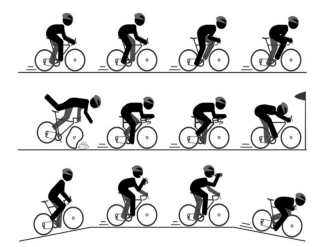
Figure 10: image of appropriate postures for when riding a an E-Bike (Happy Writers Co, 2022)
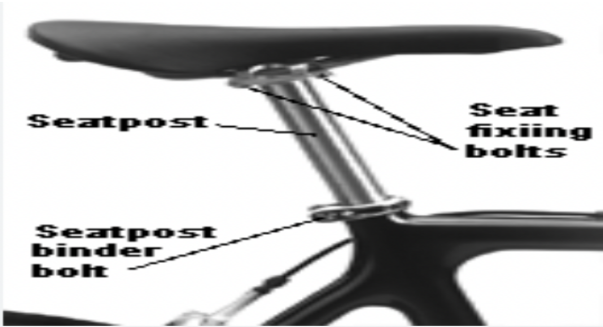
Figure 11: The components of a an E-bike seat (Ioannis, 2022)
General Accessibility Suggestion
Accessibility for mobility means creating affordable and accessible mobility solutions for all passengers. This not only involves considering people with registered disabilities, but any form of impairment, regardless of whether they are permanent or not (UITP, 2021). This section will suggest solutions to make E-bikes more accessible for those with physical and mental limitations, not financial issues. However, optimising E-bike sharing as a form of public transport is simply non-applicable to some groups of people such as those with visual impairments with current technology. As there is an extremely wide range of impairments and specific access needs that exist, it is impossible to design an E-bike that can cover all specific needs. The solutions suggested in this paper however will discuss those with physics impairments, hearing impairments, mental health issues, and intellectual disabilities. The solutions provided aim to make E-bike sharing mobility more accessible without changing the structure of the conventional two-wheeled E-bike significantly e.g. adaptive bikeshare fleets (Washington et al., 2020). These solutions are not limited to the design of the E-bike itself but also the infrastructure surrounding it.
1. Self-balancing system
By providing a self-balancing mechanism to E-bikes, riders can more easily control the movement of the E-bike as they do not have to maintain a specific minimum speed to keep the E-bike upright. This is particularly useful for those with physical impairments as it can help prevent accidents that result from relatively weak physical ability.
One example of this technology is an automatically adjusting front fork that lowers upon decreasing past a set speed.
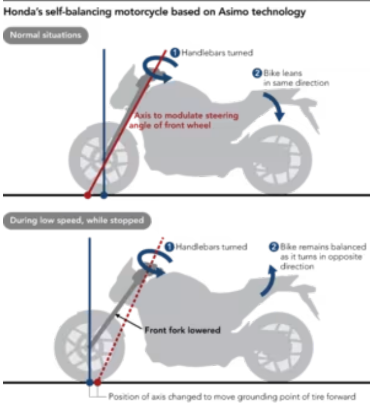
Figure 12: Diagram showing the self balancing mechanism of Honda Motor Riding Assist system (WAKASUGI, 2017).
This is based on the fact that bicycle stability is largely related to the trial of a bicycle. The larger trail value, the more stable the bike. This can be calculated using the following formula:

where Rw is the wheel radius, Ah is the head angle and Of is the fork offset. These variables are shown in figure 11 (Phred.org, 2022) .
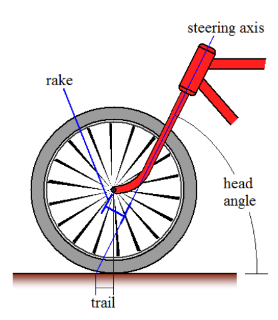
Figure 13: Image of the head of a bicycle with labelled variables involved in calculating bicycle trail (Real-world-physics-problems.com, 2022).
Using the equation, a smaller head angle can provide a larger rake value, thus increasing the stability of the bike. By lowering the front fork, the head angle is decreased and the bike becomes more stable. If designed in conjunction with an appropriate structure, this can allow an E-bike to become self balancing.
2. Cycle lanes and cycle lane improvements
While not absolutely necessary, for cycling to be effectively promoted and used, effective infrastructure should be developed. According to a survey, cycling lanes were a popular suggestion among people with various disabilities and impairments on how to improve public transport. (Hatzakis, 2021)
The following suggestions were made in the survey in regards to how to improve cycling lanes:
a. Smooth paths without bumps.
b. ‘Parking spaces’ in case people need to organise their belongings or get off and on the bike if needed. For anyone, the inability to disembark for whatever reason from a cycling lane at any point is a big disincentive to use these lanes, providing an increased potential for riders to become safety hazards to themselves as well as other riders in the lanes. This also affects the general comfort and satisfaction of the user experience. For people with impairments and disabilities, more frequent opportunities to stop riding can be very
c. Sufficiently wide lanes so that people can overtake more easily, for a safer and more comfortable riding experience, and more easily avoid intersections with other non-bike traffic. This is especially important as normal bikes and E-bikes will use the same infrastructure, so the difference in speed in these bikes need to be compensated for in this way.
d. Clear signposting and control of traffic. This affects the overall quality of the user experience of cycling lanes. As E-bikes travel at higher speeds than normal bikes, these features are crucial to providing a safe and satisfactorily usable cycling lane. This is especially important for those with hearing impairments.
Software Suggestions
A key factor in the convenience of E-bike sharing systems is the use of applied technology. This provides users the opportunity to access real-time information about E-bikes such as bike availability and cost (Midgley, 2009). It also provides information about the service, including guides on how to use E-bikes as well as the service as a whole. Because this is such a crucial aspect of the success of public E-bike sharing, making the software it utilises accessible, usable, and satisfying to use is a key point in making public E-bikes more effective and pleasurable to use in general, being essentially the first point of contact between a user and the E-bike sharing system.
a. Providing real-time information at bike-sharing points. This is discussed in the previous section with the screen installations at the bike stands and on the bikes themselves.
b. There should be simple and clear information and signage. Too many signs, gestures or information can cause anxiety and confusion. The use of pictograms or icons can be helpful for those who cannot read and make information easier to process in general. The range of colours used should also be kept to a minimum for clarity.(Design with Everyone in Mind, n.d.)
c. Text to speech or other forms of audio information can be particularly useful especially for people who cannot read such as those with extreme dyslexia or shortsightedness. An example of an accessibility tool like this is Orca’s screen reader. (Harvard Business Review, 2022)
d. Consistent style hierarchies with clear visual indicators such as colour, bolding, or underlines can allow people to more easily navigate user interfaces and recognise the importance of certain buttons or controls in the application. (Apple.com, 2022).
Conclusion
In conclusion, our research into E-bikes aimed to provide structured suggestions to optimise E-bikes to improve their accessibility, usability, satisfaction, performance, and safety using a user-centred design approach and human factor engineering.. The research was guided by a HTA that was designed based on the Neuron Mobility EB1 E-bike on which we based our baseline bike. This helped us identify the aspects of E-bikes we wanted to focus our research on. The following suggestions were made:
- Installed screens with user interfaces
- Either a large screen at each charging station or smaller individual screens on each bike
- QR code scanners and card machines on both for access without mobile phone 2. Tires
- Pneumatic tubeless tires
- 26-inch diameter
- 52 mm wide tires
- wEither cyclocross, street or commuter tires depending on weather and season 3. Battery
- Place battery inside or replace downtube in e-bike frame
- Battery usage limiter
- Solar panels to improve battery life
- Anthropometrics
- “6061 and 7005 aluminium alloy frames
- Adjustable handlebar height
- General Accessibility
- Self-balancing system
- Cycle lanes and cycle lane improvements
- Software
- Providing real-time information at bike-sharing points
- Simple and clear information and signage
- Text to speech and other forms of audio information
- Consistent style hierarchies with clear visual indicators
Overall, this research aimed to improve accessibility and optimise the potential of public E-bike use. These aims and objectives have been researched and suggestions offered that we believe could drastically improve both inclusions and all other factors around the E-bike. Ultimately, optimisation has limitless potential and the realm of possibility can always expand as new technology is developed. The people with the best perspective on how to best develop an e-bike product are the developers of that product as how a product is best optimised is heavily dependent on the environment of usage.
Reference List
An, K., Chen, X., Xin, F., Lin, B. and Wei, L. (2013). Travel Characteristics of E-bike Users: Survey and Analysis in Shanghai. Procedia – Social and Behavioral Sciences, [online] 96, pp.1828–1838. doi:10.1016/j.sbspro.2013.08.208.
Apple.com. (2022). Accessibility – Foundations – Human Interface Guidelines – Design – Apple Developer. [online] Available at: https://developer.apple.com/design/human-interface-guidelines/foundations/accessibility [Accessed 10 Dec. 2022].
Battery University (2010). Battery University. [online] Battery University. Available at: https://batteryuniversity.com/article/bu-802-what-causes-capacity-loss [Accessed 10 Dec. 2022].
Bicycling. (2022). No, E-Bikes Aren’t Here to Rob Us of Our Human-Powered Way of Life. [online] Available at: https://www.bicycling.com/skills-tips/a20044021/13-things-about-e-bikes/ [Accessed 10 Dec. 2022].
CEAT Tyres (2020). Tube or tubeless? Find the best tyre type for your bike. [online] ceat.com. Available at: https://www.ceat.com/blog/bike-tyres/tube-or-tubeless-find-the-best-tyre-type-for-your-bike.html [Accessed 10 Dec. 2022].
Cornell.edu. (2022). Anthropometrics and design. [online] Available at: https://ergo.human.cornell.edu/DEA3250Flipbook/DEA3250notes/anthrodesign.html#:~:text=%22Clinical%20normality%22%20in%20height%20is,%22%20%C2%B4%202.95%22%20for%2 0women [Accessed 10 Dec. 2022].
Design with Everyone in Mind. (n.d.). [online] Available at: https://www.itf-oecd.org/sites/default/files/docs/09cognitive.pdf.
EBikeKit.com. (2017). Electric Bike Batteries Explained. [online] Available at: https://www.ebikekit.com/blogs/news/electric-bike-batteries-explained [Accessed 10 Dec. 2022].
Ebikeschool.com. (2015). Choosing The Right Tire For Your Electric Bicycle. [online] Available at: https://www.ebikeschool.com/choosing-right-electric-bicycle-tire/ [Accessed 10 Dec. 2022].
Espinosa, D. (2022). Are E-Bikes Safer than Regular Bikes? – People Powered Movement. [online] People Powered Movement. Available at: https://www.peoplepoweredmovement.org/are-e-bikes-safer-than-regular-bikes/#:~:text=Unlike %20traditional%20bikes%2C%20e%2Dbikes,acceleration%20or%20while%20mounting%20hill s [Accessed 10 Dec. 2022]
Happy Writers Co (2022). Proper Biking Posture. [online] Achca.org. Available at: https://www.achca.org/index.php?option=com_dailyplanetblog&view=entry&year=2022&month=01&day=23&id=104:proper-biking-posture#:~:text=One%20of%20the%20best%20things,to%20develop%20for%20proper%20posture [Accessed 10 Dec. 2022].
Harvard Business Review. (2022). 3 Strategies for Developing More-Accessible Software. [online] Available at: https://hbr.org/2022/06/3-strategies-for-developing-more-accessible-software [Accessed 10 Dec. 2022].
Hatzakis, T. (2021). Views of Persons With Disabilities on Future Mobility. [online] pp.1–16. Available at: https://trips-project.eu/wp-content/uploads/2021/06/D2.1-TRIPS-White-Paper.pdf [Accessed 2 Dec. 2022].
Hiley, C. (2022). UK mobile phone statistics 2022. [online] Uswitch. Available at: https://www.uswitch.com/mobiles/studies/mobile-statistics/ [Accessed 10 Dec. 2022].
Karapedis, I. (2022). Calculation and Design of an Electric Bicycle. Ihu.edu.gr. [online] doi:https://repository.ihu.edu.gr//xmlui/handle/11544/29922.
KBO Bike (2020). Electric Bike: Thin Tire Or Fat Tire? | KBO Bike. [online] KBO Bike. Available at: https://kbobike.com/blogs/news/should-you-choose-thin-or-fat-tires-when-commuting-with-ebik es [Accessed 10 Dec. 2022].
KBO Bike (2021a). How To Choose Electric Bike Tires | KBO Bike. [online] KBO Bike. Available at: https://kbobike.com/blogs/news/how-to-choose-electric-bike-tires [Accessed 10 Dec. 2022].
KBO Bike (2021b). How To Choose Electric Bike Tires | KBO Bike. [online] KBO Bike. Available at: https://kbobike.com/blogs/news/how-to-choose-electric-bike-tires [Accessed 10 Dec. 2022].
Kroesen, M. (2017). To what extent do e-bikes substitute travel by other modes? Evidence from the Netherlands. Transportation Research Part D: Transport and Environment, [online] 53, pp.377–387. doi:10.1016/j.trd.2017.04.036.
Midgley, P. (2009). The Role of Smart Bike-sharing Systems in Urban Mobility. [online] ResearchGate. Available at: https://www.researchgate.net/publication/242235724_The_Role_of_Smart_Bike-sharing_System s_in_Urban_Mobility [Accessed 10 Dec. 2022].
Mobilities. (2021). The rise of the e-bike: Towards an extension of the practice of cycling? [online] Available at: https://www.tandfonline.com/doi/full/10.1080/17450101.2021.1897236 [Accessed 26 Nov. 2022].
MomentumPlanet.ca (2021). Recommended Bike Tires For Winter Commuting in Snow – MomentumPlanet.ca. [online] MomentumPlanet.ca. Available at: https://www.momentumplanet.ca/recommended-bike-tires-for-winter-commuting-in-snow/ [Accessed 10 Dec. 2022].
Moser, C., Blumer, Y. and Hille, S. (2018). E-bike trials’ potential to promote sustained changes in car owners’ mobility habits. [online] ResearchGate. Available at: https://www.researchgate.net/publication/322991216_E-bike_trials’_potential_to_promote_susta ined_changes_in_car_owners’_mobility_habits [Accessed 26 Nov. 2022].
Muszynski Jhrp, L. (n.d.). SEPTEMBER 1973 -NUMBER 21. [online] Available at: https://docs.lib.purdue.edu/cgi/viewcontent.cgi?article=2208&context=jtrp.
Norman, P. (2022). What is an electric bike and how do they work? [online] BikeRadar. Available at: https://www.bikeradar.com/advice/buyers-guides/what-is-an-electric-bike/ [Accessed 10 Dec. 2022].
Northern News. (2021). Northern completes scheme to install more than 600 new ticket machines across network. [online] Available at: https://media.northernrailway.co.uk/news/northern-completes-scheme-to-install-more-than-600-n ew-ticket-machines-across-network [Accessed 10 Dec. 2022].
Page, A., Cooper, A. and Bourne, J.E. (2020). How coronavirus made 2020 the year of the electric bike. [online] The Conversation. Available at: https://theconversation.com/how-coronavirus-made-2020-the-year-of-the-electric-bike-143158 [Accessed 10 Dec. 2022].
Phred.org. (2022). Bicycle Steering Geometry. [online] Available at: https://www.phred.org/~josh/bike/trail.html [Accessed 9 Dec. 2022].
Public attitudes towards train services: results from the February 2018 Opinions and Lifestyle Survey. (2019). United Kingdom Department of Transport, pp.1–39.
Real-world-physics-problems.com. (2022). [online] Available at: https://www.real-world-physics-problems.com/bicycle-physics.html [Accessed 9 Dec. 2022].
reTyre (2020). What makes the best e-Bike tyre? [online] Retyre.co. Available at: https://blog.retyre.co/blog/what-makes-the-best-e-bike-tyre [Accessed 10 Dec. 2022].
Rik van Putten (2022). THE BENEFITS OF TUBELESS TYRES. [online] FFWD Wheels. Available at: https://www.ffwdwheels.com/blogs/technology/the-benefits-of-tubeless-tyres [Accessed 10 Dec. 2022].
RNIB. (2022). Key information and statistics on sight loss in the UK. [online] Available at: https://www.rnib.org.uk/professionals/health-social-care-education-professionals/knowledge-and -research-hub/key-information-and-statistics-on-sight-loss-in-the-uk/ [Accessed 10 Dec. 2022].
Selvi, S. (2017). Impact Factor: 5.2 IJAR. [online] 3(5), pp.355–359. Available at: https://www.allresearchjournal.com/archives/2017/vol3issue5/PartF/3-4-111-169.pdf [Accessed 26 Nov. 2022].
Stanton, N.A. (2006). Hierarchical task analysis: Developments, applications, and extensions. Applied Ergonomics, [online] 37(1), pp.55–79. doi:10.1016/j.apergo.2005.06.003.
Steinmaßl, S. and Lienkamp, M. (2016). CoFAT 2016 – Customer requirements for a multitrack electric bicycle – Product development process for… [online] ResearchGate. Available at: https://www.researchgate.net/publication/308022231_CoFAT_2016_-_Customer_requirements_f or_a_multitrack_electric_bicycle_-_Product_development_process_for_multitrack_electric_bicy cles [Accessed 26 Nov. 2022].
StevenCherry (2022). Are Fat Tires Better for Electric Bikes? – 5 Reasons Why. [online] Espinbikes.com. Available at: https://www.espinbikes.com/blogs/why-e-bikes/understanding-why-wide-tires-are-better-for-e-bi kes [Accessed 10 Dec. 2022].
Tom, H. (2022). Shop now, pay with Klarna. [online] Buybestgear. Available at: https://www.buybestgear.com/blogs/guides/shop-now-pay-with-klarna [Accessed 10 Dec. 2022].
Tour Reader. (2022). Tour. [online] Available at: https://www.schwalbe.com/en/tour-reader/marathon-e-plus [Accessed 10 Dec. 2022].
UITP. (2021). UITP. [online] Available at: https://www.uitp.org/news/how-to-make-public-transport-accessible-and-inclusive-for-all/ [Accessed 9 Dec. 2022].
WAKASUGI, T. (2017). Honda rolls out a self-balancing motorcycle. [online] Nikkei Asia. Available at: https://asia.nikkei.com/Business/Honda-rolls-out-a-self-balancing-motorcycle [Accessed 9 Dec. 2022].
Washington, D., Yaffe, Larosa, M. and Bucalo, S. (2020). Inclusive Shared Mobility: Enabling Service for Older Adults and People with Disabilities Prepared for: National Aging and Disability Transportation Center. [online] Available at: https://mobilitydevelopment.org/wp-content/uploads/2020/07/SMI_NADTC_research_report.pdf [Accessed 9 Dec. 2022].
Weiss, M., Dekker, P., Moro, A., Scholz, H. and Patel, M.K. (2015). On the electrification of road transportation – A review of the environmental, economic, and social performance of electric two-wheelers. Transportation Research Part D: Transport and Environment, [online] 41, pp.348–366. doi:10.1016/j.trd.2015.09.007.
Zhsydz.com. (2020). Electronic bike solid tires VS pneumatic tires | ebike Shuangye. [online] Available at: https://www.zhsydz.com/electronic-bike-solid-tires-vs-pneumatic-tires/ [Accessed 10 Dec. 2022].
Ioannis, K. (2022). Calculation and Design of an Electric Bicycle. [online] Available at: https://repository.ihu.edu.gr/xmlui/handle/11544/29922 [Accessed 10 Dec. 2022].
ergo.human.cornell.edu. (n.d.). Anthropometrics and design. [online] Available at: https://ergo.human.cornell.edu/DEA3250Flipbook/DEA3250notes/anthrodesign.html#:~:text=% 22Clinical%20normality%22%20in%20height%20is [Accessed 10 Dec. 2022].
Happy Writers Co (2022). Proper Biking Posture. [online] www.achca.org. Available at: https://www.achca.org/index.php?option=com_dailyplanetblog&view=entry&year=2022&month =01&day=23&id=104:proper-biking-posture#:~:text=One%20of%20the%20best%20things [Accessed 10 Dec. 2022].




